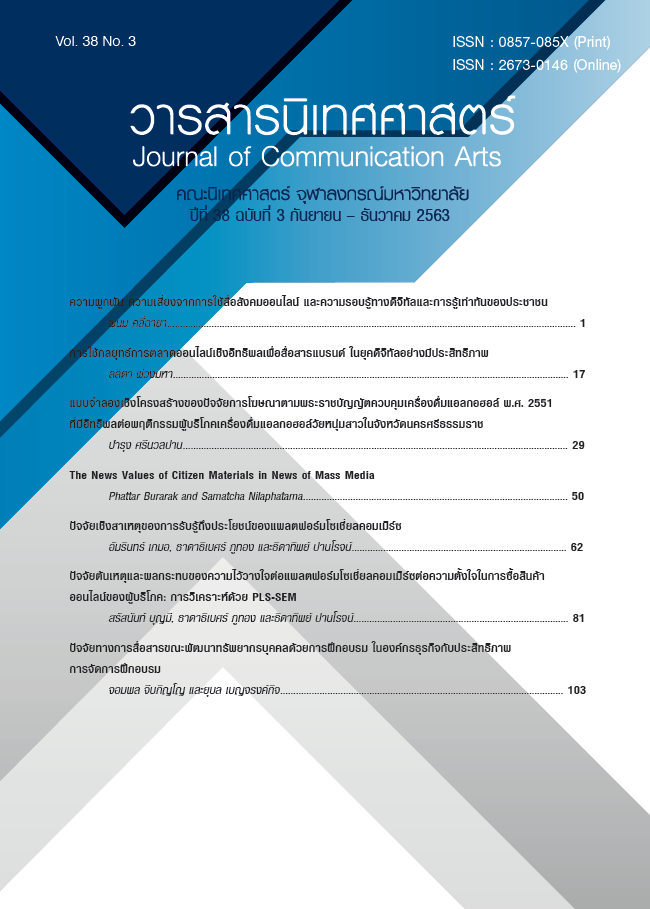Thai People’s Engagement, Risk from Social Media and Competence in Digital Intelligence and Literacy
Main Article Content
Abstract
The research aims to explore engagement and risk of social media uses and to measure level of digital intelligence and literacy of Thai people. The mix-method approach is applied. The interview was conducted to develop questionnaire for. The sample are 4 age-groups; 15-22, 23-39, 40-59 and 60 ups years old. The survey was conducted with 2,580 sample from nationwide. The survey results indicate that sample mostly use LINE, Face Book, and Youtube. They frequently use such media 7-8 times in a day with duration time spending of half to one hour. They mostly use social media for entertainment, chatting and working or studying. Regarding to sample’s social media engagement, they indicate their engagement with social media in moderate level. They post their story on social media. The survey result indicates top 5 risk situation that the sample experienced from social media that is firstly violent content, illegal advertisement, fabulous health content, fake news and sexual content. The sample obtain digital intelligence and literacy in high level. However, the sample have moderate ability in media text understanding and social communication.
Article Details
References
คณะกรรมาธิการขับเคลื่อนการปฏิรูปประเทศด้านการสื่อสารมวลชน. (2560). ผลการศึกษาและข้อเสนอแนะการปฏิรูปการใช้สื่อโซเชียลมีเดีย (Social Media). สำนักงานเลขาธิการสภาผู้แทนราษฎรปฏิบัติหน้าที่สำนักงานเลขาธิการสภาขับเคลื่อนการปฏิรูปประเทศ, คณะกรรมาธิการขับเคลื่อนการปฏิรูปประเทศด้านการสื่อสารมวลชน.
พนม คลี่ฉายา. (2559). การใช้งาน ความเสี่ยง การรู้เท่าทันสื่อดิจิทัล และแนวทางการสอนเพื่อการรู้เท่าทันสื่อดิจิทัล สำหรับนักเรียนมัธยมศึกษาในประเทศไทย. โครงการวิจัยระยะที่ 1-2. สำนักงานกองทุนสนับสนุนการวิจัย (สกว.).
พนม คลี่ฉายา. (2560). การรู้เท่าทันเกมส์ของนักเรียนมัธยมศึกษาในประเทศไทย. รายงานการวิจัย. คณะนิเทศศาสตร์, จุฬาลงกรณ์มหาวิทยาลัย.
พิมพ์พร พุฒิสาร. (2553). แรงจูงใจ พฤติกรรม และผลกระทบของวิดีโอคลิปออนไลน์. (วิทยานิพนธ์ปริญญามหาบัณฑิต). จุฬาลงกรณ์มหาวิทยาลัย, คณะนิเทศศาสตร์.
มัทนา นันตา. (2556). เว็บไซต์ยูทูบ(ภาษาไทย)กับการสื่อสารความเกลียดชัง. (วิทยานิพนธ์ปริญญามหาบัณฑิต). จุฬาลงกรณ์มหาวิทยาลัย, คณะนิเทศศาสตร์.
สถาบันจิตวิทยาความมั่นคง. (2558). แนวทางการปฏิรูปการสื่อสารมวลชนด้านสื่อเครือข่ายสังคมออนไลน์ในทศวรรษหน้าของประเทศไทย. เอกสารวิจัย, คณะนักศึกษาหลักสูตรจิตวิทยาความมั่นคง กลุ่มที่ ๔ รุ่นที่ ๑๑๕, สถาบันจิตวิทยาความมั่นคง, สถาบันวิชาการป้องกันประเทศ.
สำนักงานพัฒนาธุรกรรมทางอิเล็กทรอนิกส์ (องค์การมหาชน) (สพธอ.) (2560). รายงานผลการสำรวจพฤติกรรมผู้ใช้อินเทอร์เน็ตในประเทศไทย ปี 2560. สำนักงานพัฒนาธุรกรรมทางอิเล็กทรอนิกส์ (องค์การมหาชน) (สพธอ.).
สำนักสถิติแห่งชาติ (2560). สรุปผลที่สี่สำคัญการสำรวจการมีการใช้เทคโนโลยีสารสนเทศและการสื่อสารในครัวเรือน พ.ศ. 2560. สำนักสถิติแห่งชาติ.ศาสตร์และนวัตกรรมการจัดการ.
เอมิกา เหมมินทร์. (2556). พฤติกรรมการใช และความคิดเห็นเกี่ยวกับผลที่ไดจากการใชเครือขายสังคม ออนไลน (Social Media) ของประชาชนในเขตกรุงเทพมหานคร. (วิทยานิพนธ์ปริญญามหาบัณฑิต). สถาบันบัณฑิตพัฒนบริหารศาสตร์, คณะสถิติประยุกต์.
Avidar, R. (2018). Engagement, Interactivity, and Diffusion of Innovations The Case of Social Businesses. In K. A. Johnston and M. Taylor (eds), The Handbook of Communication Engagement. (pp. 505-514), First Edition, John Wiley & Sons, Inc. Published 2018 by John Wiley & Sons, Inc.
Balasooriya, I., Mor, E., & Rodríguez, M. E. (2018). Understanding User Engagement in Digital Education. In P. Zaphiris and A. Ioannou (Eds.), Learning and Collaboration Technologies. Learning and Teaching, (pp. 3-15). Springer Nature.
Bhatt, S. (2017). How Digital Communication Technology Shapes Markets, Redefining Competition, Building Cooperation. Palgrave Advances in the Economics of Innovation and Technology.
Blank, G., & Lutz, C. (2016). Benefits and harms from Internet use: A differentiatedanalysis of Great Britain. new media & society, 1-23.
Chang, F.-C et al. (2016). Urban–rural differences in parental Internetmediation and adolescents’ Internet risks in Taiwan. Health, Risk & Society, 18(3-4), 188-204.
Couch, D., Liamputtong, P., & Pitts, M. (2012). What are the real and perceived risks and dangers of online dating? Perspectives from online daters. Health, Risk & Society, 14(7-8), 697-714.
Cvijikj, I. P., & Michahelles, F. (2013). Online engagement factors on Facebook brand pages. Soc. Netw. Anal. Min., 38, 843–861.
Gainsbury, S. M et al. (2015). How risky is Internet gambling? A comparison of subgroups of Internet gamblers based on problem gambling status.media & society, 17(6), 861–879.
Helsper, E., & Eynon, R. (2013). Pathways to digital literacy and engagement. European Journal of Communication, 28(6), 696-713.
Helsper, E. J. (2015). Inequalities in digital literacy: definitions, measurements, explanations and policy implications. Retrieved September 13, 2019, from http://eprints.lse.ac.uk/68329/
Jones, L. M., & Mitchell, K. J. (2015). Defining and measuring youth digital citizenship. New Media & Society, 17(6), 1-17.
Kuipers, G (2006). The social construction of digital danger: debating,defusing and inflating the moral dangers of online humor and pornography in the Netherlands and the United States. new media & society, 8(3), 379-400.
Mowlabocus, S. (2015). ‘Y’all need to hide your kids, hide your wife’: Mobileapplications, risk and sex offender databases. media & society, 18(11) 2469–2484.
Nelson, J. L., & Taneja, H. (2018). The small, disloyal fake news audience: The role of audience availability in fake news consumption. new media & society,1–18.
O’Brien, H. (2016). Theoretical Perspectives on User Engagement. In H. O’Brien, P. Cairns (eds.), Why Engagement Matters, (pp. 1-26).
OʼBrien, H. L. (2011). Exploring User Engagement in Online News Interactions. Proceedings of the American Society for Information Science and Technology 48(1), 1-10.
Oh, J., Bellur, S., & Sundar, S. S. (2018). Clicking, Assessing, Immersing, and Sharing: An Empirical Model of User Engagement with Interactive Media. Communication Research, 45(5) 737–763.
Rodríguez-de-Dios, I., van Oosten, J. M. F., & Igartua, J.-J. (2018). A study of the relationship between parental mediation and adolescents’ digital skills, online risks and online opportunities. Computers in Human Behavior, 82, 186-198.
Trepte, S. et al (2015). Do People Know About Privacy and Data Protection Strategies? Towards the “Online Privacy Literacy Scale” (OPLIS). In S. Gutwirth et al. (eds), Reforming European Data Protection Law. (pp. 333-365). Law, Governance and Technology Series, vol 20. Springer, Dordrecht.
White, C. M., Gummerum, M., Wood, S., & Hanoch, Y. (2017). Internet Safety and the Silver Surfer: The Relationship Between Gist Reasoning and Adults’ Risky Online Behavior. Journal of Behavioral Decision Making, J. Behav. Dec. Making, 30, 819–827.
Yamakami, T. (2012). Digital Social Literacy: Literacy Demands for the Virtual-World. In R. Benlamri (Ed.) Networked Digital Technologies, Part II (pp. 429–437). Springer-Verlag Berlin Heidelberg.


